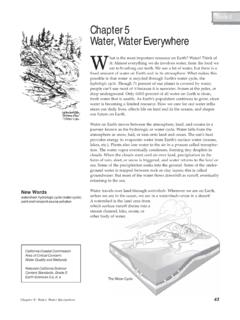Transcription of Weathering, Erosion, and Deposition
1 1 weathering , erosion , and DepositionHave you ever looked at the land around you and wondered how it was shaped? The geologic features that help define the world are still being shaped by the natural processes of weathering , erosion , and Deposition . These processes affect land differently, depending on the types of soil, rocks , and vegetation found in an ecoregion. These processes can also be affected by other natural features, such as climate and topography. Later in this companion, you will learn how human activities can also affect how weathering , erosion , and Deposition shape the is the process by which rocks are broken down into sediments slowly over time. There are two major types of weathering : mechanical (or physical) and weathering breaks down rocks into smaller pieces called sediments through physical processes. Mechanical weathering changes the shape and size of a rock, but it doesn t change the rock s chemical composition.
2 Wind and water are two of the main agents that cause mechanical weathering . Other agents include living things and changing temperatures. (An agent is something that causes something else.)For example, winds can pick up small particles and blast them against rock, slowly scraping away at the rock over time. Moving water can weather rocks in a similar way; water often carries larger particles that scrape away at the rock more quickly. Millions of years ago, the Colorado River flowed over relatively flat land in what would become the southwestern United States. Over time, the river slowly carved away the rocks and carried the sediments downstream. This process created a depression in the flat land that gradually became a deep, wide canyon that we today call the Grand : a region s typical weather conditions over a long period of timetopography: the surface features of a region, includinghow the land rises to form mountains and falls to form valleysLike many canyons, the Grand Canyon was created through mechanical weathering by water flowing in the Colorado can also weather rocks by getting into cracks and freezing.
3 When water freezes, it expands. When the water freezes in the cracks, it pushes the rocks apart. Plants growing in the cracks of a rock can also push apart the rock in a similar manner. Drastic changes in temperature, from fires or volcanic activity , can also cause rocks to crack and break down as they expand and contract from heating and weathering breaks down rocks through chemical processes that change the chemical composition of the rocks . For example, when carbon dioxide in air dissolves in rain water, carbonic acid is formed. This can dissolve some rocks , including limestone. Oxygen can also cause chemical reactions that weather rocks . Many rocks contain minerals that are composed of the element iron. Oxygen in the air or dissolved in water can cause the iron in these minerals to rust or oxidize. Rusting changes the iron (Fe) into iron oxide (Fe2O3), a different kind of rocks are better able to withstand weathering agents than others.
4 rocks made of quartz, a very hard mineral, are highly resistant to mechanical weathering . Limestone, made of the mineral calcite, is the opposite of quartz. It is very easy to dissolve through chemical weathering . When a region contains many rock types, those that are more resistant to weathering will take longer to break down. This is called differential weathering . Differential weathering can shape the landscape by leaving peaks of highly resistant rocks and holes or depressions where less resistant rocks have been broken weathering can create unique landforms like the one shown above. weathering by wind created this rock formation. The less resistant rock weathered away, while the more resistant rock caves are formed as a result of chemical weathering , when large areas of limestone are dissolved by acidic , erosion , and Deposition3As water laps against the shore, it erodes bits of rock. Blowing winds and the force of gravity also carry sediments into the breaks rocks down into sediments, and the process of erosion moves these sediments to other locations.
5 Water liquid and frozen is an important agent for erosion . Flowing water can carry rocks , sediments, and soil downstream. The faster the water flows, the larger the particles it can carry. These particles may scrape against each other or nearby rocks , causing mechanical weathering at the same time as erosion . Glaciers large sheets of moving ice can also cause mechanical weathering , ripping chunks of rock out of the ground as they move across the land. The rocks and sediments caught up in a glacier are carried along the glacier s path, causing is another agent of erosion . Compared to water, winds usually carry smaller sediments. As these sediments scrape against rock in the wind s path, they can cause mechanical weathering at the same time as erosion . Animals are agents of erosion as they burrow into the ground, moving sediments out of their erosional agent is gravity, which constantly pulls rocks downhill. Many rocks break as they erode downhill, causing additional mechanical weathering and erosion tend to occur at the same time, rocks that are carried long distances by erosion tend to be more weathered.
6 These rocks tend to be broken into smaller pieces and become more rounded. rocks that are carried shorter distances, particularly through gravity, tend to have larger pieces with more angular edges. Differential weathering also plays a role. For example, if many different types of rocks are carried downstream for the same amount of time, those that are more resistant to weathering tend to be larger and less rounded than those that are less people confuse weathering and erosion or use the terms interchangeably. While weathering and erosion often happen at the same time, they are not the same processes. weathering is the process by which rocks are broken down. erosion is the process by which rocks , sediments, or soil are moved or carried , erosion , and Deposition4As a river flows into the ocean, sediments carried by the flowing water begin to pile up around the river s mouth. These sediments create rich deposits of land, called deltas.
7 Deltas are excellent places to farm because their soil contains many nutrients picked up along the river s path to the , rocks , and soil cannot keep moving forever. Eventually, the particles stop moving and settle where the erosional agents have carried them. This process is called Deposition . When sediments are eroded by wind, flowing water, ice, or gravity, they are deposited in horizontal layers. The oldest layer of sediments is positioned at the bottom, and the more recently deposited layers are at the top. Depending on which agents caused the erosion , the sediments may be deposited in different you think of some other landforms caused by weathering , erosion , or Deposition ?Human ActivitiesWeathering, erosion , and Deposition are natural processes. However, human activities can affect how these processes shape the land. Humans can cause mechanical weathering and erosion by digging into the ground and moving rocks , sediments, and soil to other places during construction.
8 The roots of trees and other plants help hold soil in place. When humans cut down trees, the soil loses its support and becomes more vulnerable to are deposited in horizontal , erosion , and Deposition5 Pollution from cars, factories, and other human activities can also put more chemicals in the air and water. This makes it easier for chemical weathering to occur. For example, pollution can mix with water vapor in the atmosphere and fall as acid rain. Acid rain can easily dissolve limestone, as you can see in the photograph to the in sea level) and the piles of sediment were high enough to rise above sea level, creating a barrier , many people have built homes and other structures on barrier islands. People enjoy living near the beach, so barrier islands are popular places for resorts and summer homes; however, this is not always safe. Barrier islands are exposed to ocean waves and erode easily. This is especially dangerous during violent storms like hurricanes, which cause powerful winds and waves that sweep sediments from the island into the ocean.
9 This can damage or collapse buildings along the shoreline, as well as increase the risk of flooding as the ground is washed away. In 2008, Hurricane Ike made landfall over Galveston, killing 17 people and causing billions of dollars worth of of Galveston, Texas,re-enter the city two weeks after Hurricane Ike made Science: Galveston Barrier Island SystemGalveston, Texas, lies on a special type of island called a barrier island. A barrier island is a long, narrow island that stretches along a coastline. A typical barrier island is separated from the mainland by a small, shallow stretch of water such as a bay or lagoon. Barrier islands help protect the shoreline from weathering and erosion by waves and islands are made of small, fine-grained sediments. Scientists are not entirely certain how barrier islands formed. One hypothesis is that barrier islands formed through erosion and Deposition caused by flooding after the last ice age.
10 Thousands of years ago, glaciers on land began to melt. As water from the melting glaciers flowed downhill to the sea, it weathered and eroded sediment. As the water flowed into the ocean, it slowed down, depositing larger, heavier sediment further inland, and smaller, fine-grained sediment further into the ocean. This process continued until the glaciers had finished retreating (leading to aWeathering, erosion , and Deposition6 What do you know?Several processes can cause changes to the land. Read some characteristics of these processes in the box below. Then study the photographs on the next page. Decide which characteristics in the box describe what you see in each photograph, and then write each characteristic in the appropriate space below. Some characteristics will describe more than one of Processes Grains have been eroded a great distance. Grains have been eroded a short distance. Differential weathering .)






